

Chapter XII
Conventional Signs and Abbreviations
1. SOURCES a. The geographic signs included under paragraph 1 of the next section are selected from those appearing on maps of the Japanese Empire prepared by the Imperial Land Survey Department. Variant or supplementary signs used by the Japanese Hydrographic Office are listed in paragraph 2. Section I. INTRODUCTION
b. The military signs and abbreviations included under sections III and IV have been selected from Supplement No. 1 of Japanese Field Service Regulations (Military Signs), August 1940 (Sakusen Yomurei Furoku Sono Ichi, Guntai Fugo), and are supplemented by information from otherh sources. The grouping of the Army signs follows that adopted by the Japanese; the Navy and Special Naval Landing Force signs are arranged arbityrarily. The abbreviations are arranged alphabetically.
2. GENERAL PRINCIPLES. a. Military signs. (1) General. A study f the lists of Japanese mililtary signs will reveal certain basic signs and principles, a knowledge of which will aid in the interpretation of the signs. It si emphasized, however, that the Japanese do not exhibit a great degree of consistency in the formation of their signs. Furthermore certain signs considered obsolete may recur, and individual initiative in the drawing of extemporary signs, with explanatory notes if considered necessary, is condoned by the Japanese.
(2) Basic signs. Examples of basic signs follows:
, field artillery;
, cavalry;
, engineers;
, air (Army);
, air (Navy);
or
, tank;
, shipping;
, signal;
, radio;
, gas;
(placed over the rest of the sign), established depot.
(3) Headquarters. Headquarters, down to the battalion level inclusive, usually are distinguished by flags and/or circles. Brigade or group headquarters, however, are indicated by six-pointed stars
. The appropriate basic sign may be added to indicate the arm. For example:
, area army headquarters;
, division headquarters;
, cavalry brigade headquarters;
, infantry battalion headquarters;
, field artillery regimental headquarters.
(4) Units. The normal method of designating units is by adding a rectangle below the sign (in full or abbreviated) of the particular arm or weapon. For example:
, medium mortar,
, medium mortar unit;
, engineer (basic sign),
, engineer unit. (An exception to this principle should be noted:
, field artillery,
, field artillery ammunition train.)
(5) Motorization. In order to show that a unit is motorized, two rings (reprseenting wheels) are added either below or at the side of the particular sign. For example:
, field artillery ammunition train,
, field artillery ammunition train, motorized.
(6) Compound signs. Basic signs such as those described above may be combined into compound signs. For example:
antiaircraft artillery regimental headquarters.
(7) Classification. An appropriate symbol, number, or abbreviation (either English letters, "kana", or characters) may be added to a sign when it is necessary further to classify the unit or equipment indicated by the sign. For example:
, mobile ground radio station,
, No. 3 type mobile graound radio station;
, ship (general),
, water supply ship (the character included
means "water),, armed ship;
, motor truck,
, repair truck,
, truck loaded with machine guns;
, tank,
, light tank. The most common of such examples are noted in the list of signs.
(8) Boundaries, directions. Boundaries of districts or limits of fortified areas are shown by linesx; directions of shooting, points of attack, and changes of direction of troops are shown by arrows.
b. Military abbreviations. (1) English letters,both capital and small, normally are used in miliary abbreviations.
(2) The basic army abbreviationsn appear in most cases to be derived from German words and, in the case of most recent additions, romanized forms of Japanese words. For example: BA (Bergartillerie), mountain artillery; SeE (Sempaku eiseitai hombu), shipping medical unit headquarters. (3) Naval abbreviations are derived largely from English words and less freqnetly from romanized forms of Japanese words. For example: BC, battle-cruiser; cdg, combined destroyer group; AtB (Attached "butai"), attached force.
c. Numbers. The numbers of units and weapons are shown by placing the appropriate figure, either Arabic or Japanese, with necessary additions, in parentheses after the particular sign or abbreviation. For example
(2), two airplanes; A (
) three battalions of field artillery (the two characters in the parentheses are, respectively, "three" and the first character of the Japanese word for "battalion").
d. Identification. (1) When it is necessary to distinguish between enemy and friendly forces, the Japanese shoow signs for the former in red, for the latter in blue.
(2) In indicating the organizationnal numbers of units, Arabic numerals usually are used for all units except battalions, for which Roman numerals are used. The nummber of the lower unit precedes that of the higher organization of which it isi a part, the two being separated by a slanting line. For example: 18 P, the 18th Engineers; III/2i, 3d Battalion of the 2d Infantry Regiment. II St/1A, 2d Battalion Ammunition Train of the 1st Field Artillery Regiment.
(3) Platoons and sections usually are shown as fractions of a company. For example: 1/42/1P, 1 platoon of the 2d Company of the 1st Engineer Regiment; 1/162/5i, 1 section of the 2d Company of the 5th Infantry Regiment.
(4) Missing units of an organization are indicated by numerals, preceded by a minus sign, in parentheses. Units attached to an organization are shown similary with a plus instead of a minus sign. For example: 2ii(-7.8), 2d Infantry Regiment less the 7th and 8th Companies; 1(+iP)/2i, 1st Copmany, plus a labor unit, of the 2d Infantry Regiment.
Section II. GEOGRAPHIC SIGNS
IMPERIAL LAND SURVEY DEPARTMENT SIGNS.
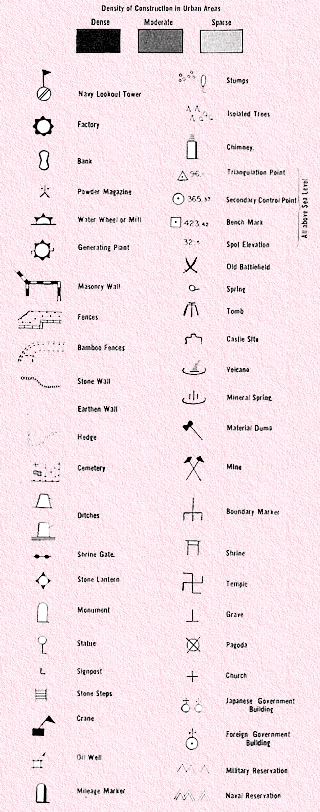

2 Japanese hydrographic office signs (signs listed are variant or supplementary to those in paragraph 1 of this section; Japanese Army shipping signs are listed in paragraph 1, section III of this chapter, Navy conventional signs in paragraph 2 of the same section).
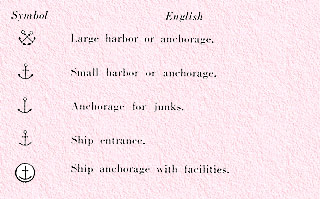
NOTE. The arrangement of the Army signs follows that adopted by the Japanese, and is outlined below. The arrangement of the Navy and Special Naval Landing Force signs is arbitrary. Section III. MILITARY SIGNS
Paragraph Army Signs 1 Common to all arms. Infantry. Cavalry Artillery. Engineers. Air, antiaircraft, and meteorological. Armored Forces. Field works. Railway. Shipping. Signal. Transport, suply, and medical services. Line of communications. Siege and fortress defense. Navy Signs 2 Special Naval Landings Force Signs 3
1. ARMY SIGNS. a. Common to all arms.
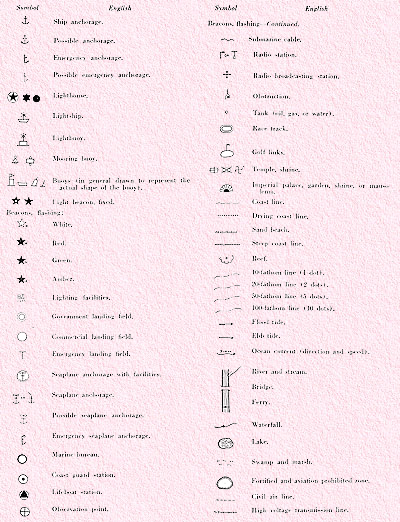
d. Artillery
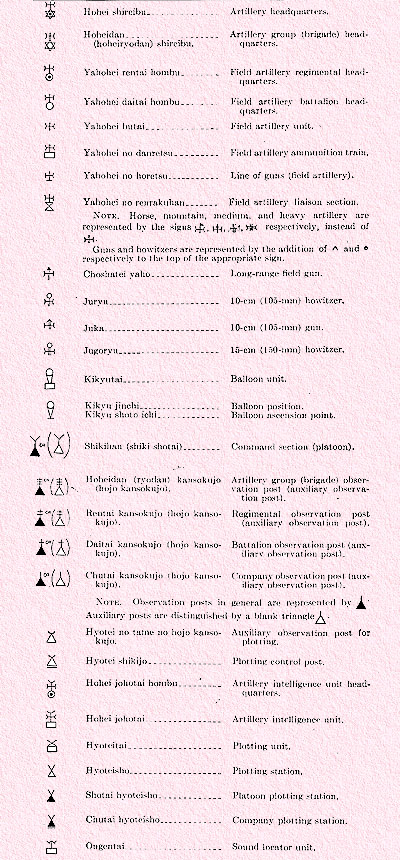
d. Artillery--Continued
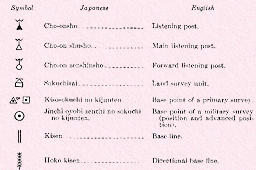

f. Air, antiaircraft, and meteorlogical
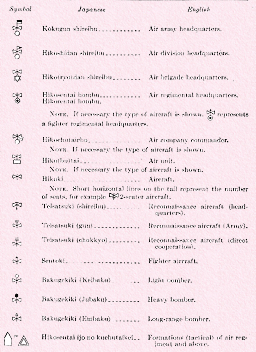
f. Air, antiaircraft, and meteorlogical--Continued
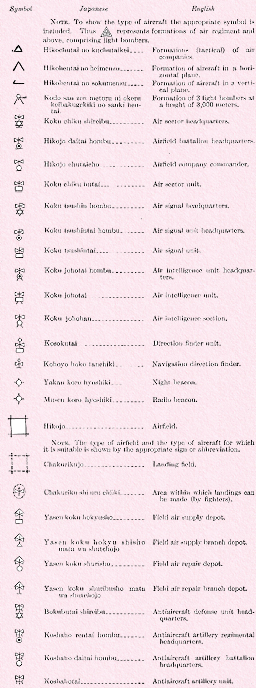
f. Air, antiaircraft, and meteorlogical--Continued
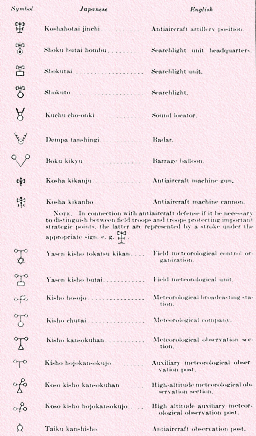
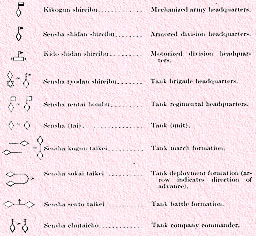
g. Armored Forces--Continued
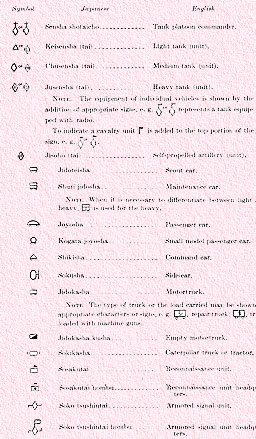
h. Field Works.
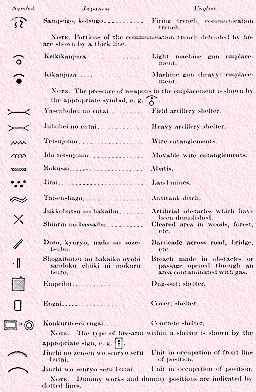

i. Railway--continued.


j. Shipping--continued.

j. Shipping--continued.
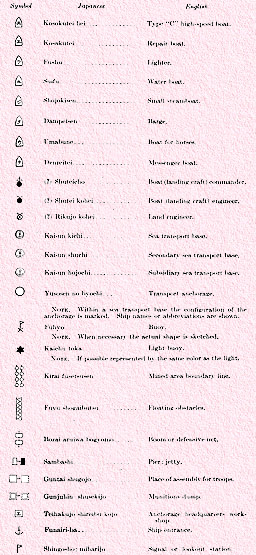
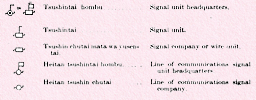
k. Signal--continued.
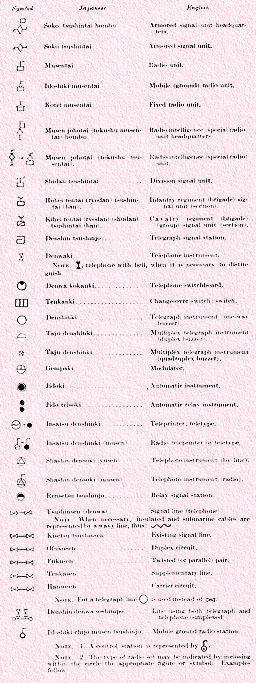
k. Signal--continued.
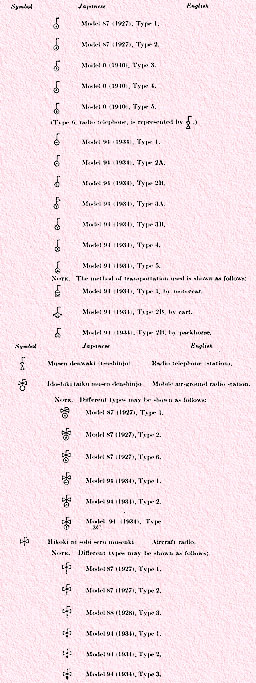
k. Signal--continued.
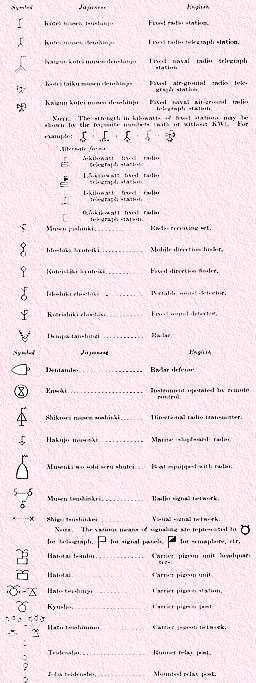
k. Signal--continued.
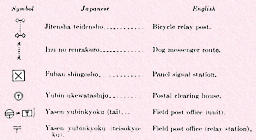
l. Transport, Supply, and Medical Services.
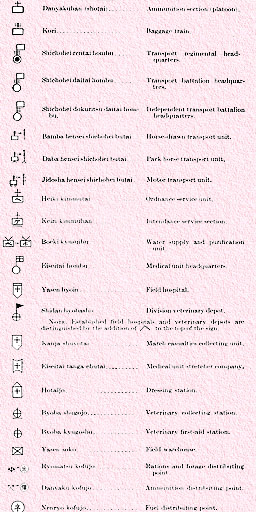
l. Transport, Supply, and Medical Services--continued.

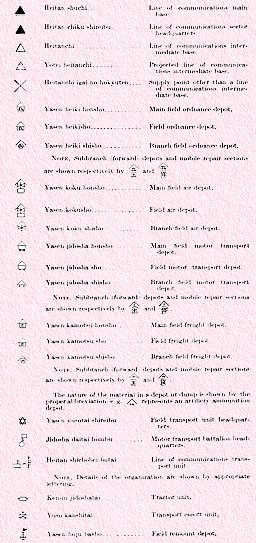
m. Line of Communications--continued.

n. Siege and fortress defense.

n. Siege and fortress defense--continued.
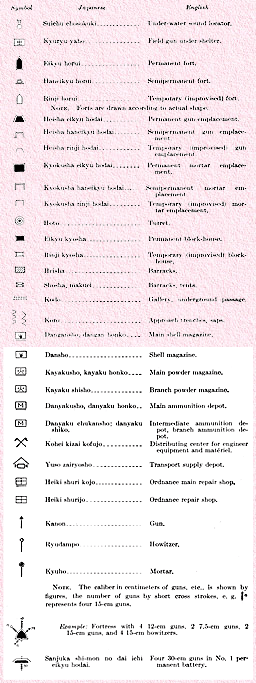
n. Siege and fortress defense--continued.

NOTE. For Army air and shipping signs see paragraph 1 of this section. Navy hydrographic signs are listed in section 1, paragraph 2, of this chapter.


b. Ships, personnel--continued
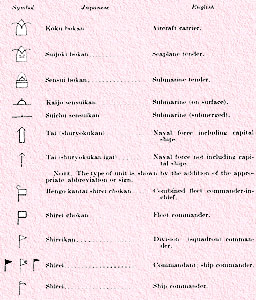
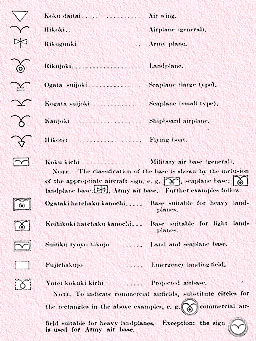
d. Fortifications, miscellaneous installations.
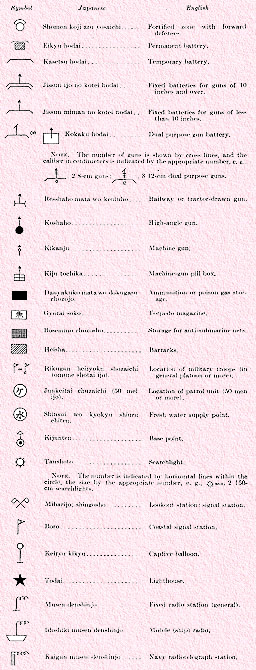
d. Fortifications, miscellaneous installations--continued.
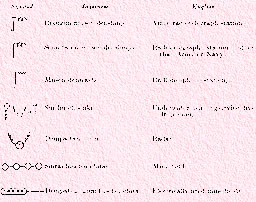
3. SPECIAL NAVAL LANDING FORCE SIGNS.
NOTE. The followng signs have been compiled from various sources, and are not considered complete or necessarily standard for all special naval landingn forces. Although Navy signs are used wherever appropriate (e.g., the basic sign for aircraft), most of the signs are identical or similar to the corresponding Army signs because the functions and equipment of naval landing forces resemble more closely those of the Army than of the Navy.
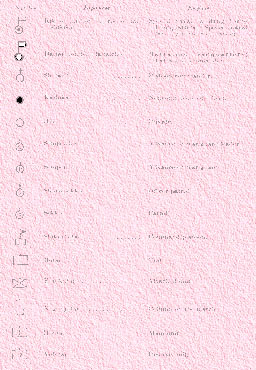
3. SPECIAL NAVAL LANDING FORCE SIGNS--Continued.
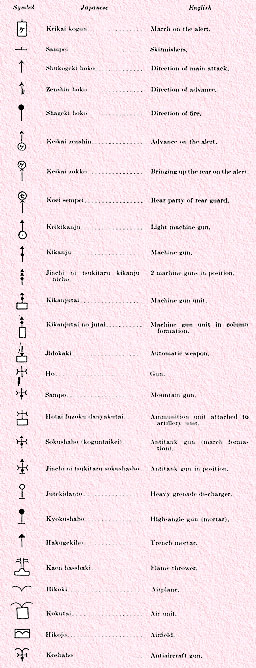
3. SPECIAL NAVAL LANDING FORCE SIGNS--Continued.
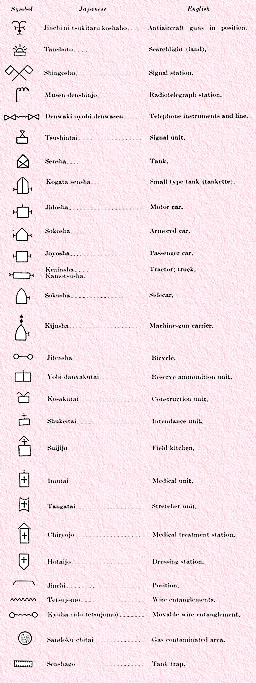
3. SPECIAL NAVAL LANDING FORCE SIGNS--Continued.

Section IV.--MILITARY ABBREVIATIONS
NOTE. The abbreviations are arranged alphabetically.
Abbreviation Japanese English A Gun Army. A Yahohei Field artillery. AA Koshahotai; koshaho jinchi Antiaircraft artillery unit; antiaircraft artillery position. AAS Dokuritsu koshohotai Independent AA unit. ab Hokojo daitai Airfield battalion. ac Hokojo chutai Airfield company. AE Yasen kisho butai Field meteorological unit. AL Hyoteitai Plotting unit (artillery). AM Hohei danyaku Artillery ammunition. NOTE. The kind of ammunition is represented as follows:
BAM, Mountain artillery ammunition.
SAM, Medium artillery ammunition.AMT Hohei danyaku chutai Artillery ammunition company. AN Hohei johotai Artillery intelligence unit. AP Keikyu shugojo Alarm post. AQ Shokutai Searchlight unit. AQS Dokuritsu shokutai Independent searchlight unit. AS Ongentai Sound locator unit (artillery). AT Sokuchitai Land survey unit (artillery). ATK Hosensha (tai) Tank destroyer (unit). ATL Tsushintai hombu Army signal unit headquarters. B Ryodan, mata wa kore ni junzuru mono Brigade, or its equivalent. b Daitai Battalion. BA Sampohei Mountain artillery. BAS Dokuritsu sampohei Independent mountain artillery. BAM Sampohei danyaku (See AM above). BG Yasen sakuseitai Field well-construction unit. biA Daitaihotai Infantry battalion gun unit. BiZ Hohei ryodan gasu butai Infantry brigade gas unit. BK Gakoi zairyo chutai Bridging matériel company. BM Byodan danyakuhan Brigade ammunition section. Bo (BO) Boeki kyusuibu Water supply and purification unit. BS Dokuritsu konsei ryodan Independent mixed brigade. BSAA Dokuritsu konsei ryodan koshahotai. Independent mixed brigade AA unit. BSP Dokuritsu konsei ryodan kohei. Independent mixed brigade engineer unit. BTL Hohei ryodan tsushintai (han). Infantry brigade signal unit (section). C Gundan Corps (not part of the Japanese Army organization). c Chutai Company. D Shidan Division. DK Shidan kihei Division cavalry. DO Yasen dorotai Field road unit. DP Shidan kohei Division engineers. DT Shidan shicho Division transport. DTL Shidan tsushintai Division signal unit. E Tetsudotai Railway unit. FA Kokugun (formerly kokuheidan). Air army. FA Yosai hohei Fortress artillery. FB Hiko (ryo) dan Air brigade. Fc Hikochutai Air company. FD Hikoshidan Air division. FeA Juhohei Heavy artillery. FeAS Dokuritsu johhei Independent heavy artillery. FIS Dokuritsu koku chikutai Independent air sector unit. FL Yasen byoin Field hospital. FM Hikobutai Air unit. FN Koku hojotai Air intelligence unit. FP Yosai kohei Fortress engineers. FR Hikosentai (rentai) Air regiment. NOTE. Reconnaissance, fighter, or bomber aircraft are shown by putting O, C, or B respectively on the lower right side of the abbreviation. Similarly light, heavy, or long-range aircraft are shown by L, S, or T, respectively.
Examples:
FRO, Air regiment (reconnaissance aircraft).
FRSC, Air regiment (heavy fighter aircraft).
FRLB, Air regiment (light bomber aircraft).FS Yasen kanja shuyotai Field casualty collecting unit. FTL Koku tsushintai Air signal unit. FW Hikojo setteitai Airdrome construction unit. G Konoe Imperial Guards. GAP Keikyu daishugojo Grand alarm post. Gr Jidosha (hikoki) nenryo Automobile (aviation) fuel. H Ryudampo Howitzer.
1. ARMY ABBREVIATIONS--Continued.
Abbreviation Japanese English HA Koshaho AA gun. HeF Hansui sagyotai Boat launching unit. HFL Heitan byoin Line of communications hospital. HMA Kosha kikanho Antiaircraft machine cannon. HMG Kosha kikanju Antiaircraft machine gun. Hr Eisei zairyo Medical company. i Hohei Infantry. iA Hohei hotai Infantry gun unit. iB Hohei ryodan Infantry brigade. iH Kyokusha hohieho Infantry mortar. iK Heisha hoheiho Infantry cannon (gun). iM Hohei danyaku Infantry ammunition. NOTE. The kind of ammunition is represented as follows:
iM (MG), Machine gun ammunition.
iM (TA), Antitank gun ammunition.iMT Hohei danyaku chutai Infantry ammunition train. iP Sagyotai Labor unit (infantry pioneers). iR Hohei rentai Infantry regiment. iRS Doduritsu hohei rentai Independent infantry regiment. iS Dokuritsu hohei Independent infantry. iTL Hohei rentai tsushintai (han). Infantry regiment signal unit (section). K Kanon Cannon (gun). K Kihei Cavalry. KA Kohohei Cavalry (Horse) artillery. KaY Kaijo yuso daitai hombu Sea transport battalion headquarters. KB Kiihei ryodan Cavalry brigade. KBA Kihei ryodan hotai Cavalry brigade artillery unit. KBAA Kihei ryodan koshahotai Cavalry brigade AA unit. KBT Kihei ryodan shicho Cavalry brigade transport. KBTAS Kihei ryodan dokuritsu sokushahotai. Cavalry brigade independent antitank unit. KBTK Kihei ryodan senshatai Cavalry brigade tank unit. KBTL Kihei ryodan tsushinhan (tai). Cavalry brigade signal section (unit). KD Kihei shidan Cavalry division. Kg Shubitai Guard detachment, garrison. KgS Dokuritsu shubitai Independent garrison. Ki Kikyutai Balloon unit. KK Kihei shudan Cavalry group. KKTL Kihi shudan tsushinhan Cavalry group signal section. KS Dokuritsu kihei Independent cavalry. KTK (See TK below). KTL Kihei rentai tsushinhan (tai). Cavalry regimental signal section (unit). LBK Toka zairyo chutai River crossing matériel company. LG Keikikanju Light machine gun. LM Kkeihakugekihotai Light trench mortar unit. LTK (See TK below). M Kyuho Mortar. M Danyakuhan (shotai) Ammunition section (platoon). MA Kikanhotai Machine cannon unit. MD Kido shidan Motorized division. MG Kikanjutai Machine gun unit. MM Chuhakugekihotai Medium trench mortar unit. MS Dokuritsu hakugekihotai Independent mortar unit. MTK (See TK below). MW Tekidanto, tekidanju Grenade discharger, grenade rifle. N Kori Baggage or train. N Johotai Army intelligence unit. NA Kaigunho Naval gun. NSF Kotei musentai Fixed radio (wireless) unit. P Kohei Engineers. PA Kokogun Mechanized army. PD Shidan byobasho Division veterinary hospital. Pr Ryomatsu Provisions and forage. PrT Ryoshoku chutai Provision train. PS Dokukritsu kohei Independent engineers. PT Hatotai; shikyutai Carrier pigeon unit. PW Sokoshatai Tankette unit. PWS Dokuritsu sokoshatai Independent tankette unit. R Rentai Regiment. RD Tokushu musentai Special radio unit. RiA Rentai hotai Infantry regimental gun unit. RSt Rentai danretsu Regimental ammunition train. S Dokuritsu Independent NOTE. Added at the end of the unit abbreviation. S Kanja shuyotai March casualties collecting unit. SA Yasen juhohei Medium artillery. SAM Yasen juho danyaku (See AM above). SAS Dokuritsu yasen juhohei Independent medium artillery. SeA Sempaku hohei rentai Shipping artillery regiment. SeAA Sempaku koshahotai Shipping antiaircraft unit. SeC Sempaku shireibu Shipping headquarters. SeD Sempaku dan shireibu Shipping group headquarters. SeE Sempaku eiseitai hombu Shipping medical unit headquarters. SeH Sempaku heidan shireibu Large shipping group headquarters. SeK Sempaku kosakusho Shipping repair depot. SeP Sempaku kohei rentai Shipping engineers regiment. SeS Byoinsen eiseihan Hospital ship medical section. SeT Teihakujo shireibu Anchorage headquarters. SeTi Sempaku yuso chikutai shireibu Shipping transportation area unit headquarters. SeTL Sempaku tsushin rentai Shipping signal regiment. SeU Sempaku yuso shireibu Shipping transportation headquarters. SeUb Kaijo yuso daitai Sea transport battalion.
Abbreviation Japanese English SeY Yorikutai Disembarkation unit. SF Musentai Radio unit. SM Juhakugekihotai Heavy trench mortar unit. SO Sosakutai Reconnaissance unit. STK (See TK below). St Danretsu Ammunition train. SuB Suijo shireibu Headquarters at sea. SW Yasen shomeitai Field searchlight unit. T Shicho Transport. TA Sokushahotai Antitank gun unit. TAS Dokuritsu sokushahotai Independent antitank gun unit. TD Sensha shidan Armored division. TG Yusosentai Group of transport; convoy. TG Tommy gun. TK Sensha (tai) Tank (unit). NOTE. Light, medium, or heavy tanks are represented by putting L, M, or S, respectively, in front of the abbreviation. For example, STK represents a heavy tank unit. A tank unit employed as cavalry is represented by KTK. TKP Senshatai kohei Tank unit engineers. TKS Dokuritsu senshatai Independent tank unit. TKTL Senshatai tsushintai Tank unit signal unit. TL Tsushin chutai, mata was yusentai Signal company; wire unit. TLS Dokuritsu tsushin chutai Independent signal company. TP Kikaika butai Mechanized unit. TZ Senshatai no seibi butai Tank unit maintenance unit. V Yasen sokuryotai Field surveying unit (engineers). Vr Jui zairyo Veterinary supply. Z Gasu butai Gas unit. Zid Jidohotai Automatic gun unit. Zr Kagakusen shizai Chemical warfare. ZS Dokuritsu gasu butai Independent gas unit.
Abbreviation Japanese English A Koku bokan Aircraft carrier. a Suijo hikoki Seaplane. Aa (Aa) Hikotei (hokosen ?) Flying boat (dirigible ?) AB Kushu butai Air attack force. aBg Tokubetsu konkyochitai Special base unit. AdB Zenshin butai Advancing force. AF Koku kantai Air fleet. AG Tokusetsu hokan Auxiliary gunboat. As or As Suijoki bokan Seaplane tender. AtB Fuzoku butai Attached force. B Sentokan; senkan Battleship. BC Junyo senkan Battle-cruiser. BG Bobitai Naval defense force. Bg Konkyochitai Base unit. bg Keibitai Guard unit. BS Senkan sentai Battleship division. C Junyokan Cruiser. C1 (?) Itto junyokan Heavy cruiser. CA or CA Itto junyokan; ko junyokan. Heavy cruiser. CAS or CAS Sentai Heavy cruiser division. CB or CB Otsu junyokan Light cruiser (2d class cruiser). CB Tsushin butai Communication unit. CD Kaibokan Coast defense vessel. cdg Kuchiku rentai Combined destroyer group. CF Kenshi kantai China Expeditionary Fleet. cfg Koku rentai Combined air unit. Cg Tsushintai Communication unit. ch Kusentai Sub-chaser. chg Kusentai Sub-chaser group. Cl or CL Denran fusetsusen Cable layer. CM Kirai fusetsusen Minelayer. CS Junyokan sentai Cruiser division. CsF Shina homen kantai China Area Fleet. cwg Sokai rentai Combined mine-sweeper group. D Shotai Division. d Kuchikukan Destroyer. Df Koku bokan; kobo (abbr.) Aircraft carrier. dg Kuchikutai; kuchi or ku (abbr). Destroyer group. Dp Bokan Depot ship. Dpd Suirai bokan Destroyer (mine) depot ship. Dpf Koku bokan Aircraft tender or depot ship. Dps Sensui bokan Submarine tender. Dpw Sokai bokan Mine-sweeper depot ship. EB Senken butai Advance force. EF Goei kantai Escorting fleet. Eg Goei tai Escort unit. EV Gosokan Escort vessel. F Kantai Fleet. f Hikoki; ki (abbr) Aircraft fB Koku butai Naval Air Force. fb (fb) Bakugekiki: kogekiki Bomber aircraft. fb (fb) Kamjoki Ship-borne plane. fc (fc) Sentoki Fighter aircraft. fd (fd) Hokotei Flying boat. fd Ogatas hikotei Large flying boat. fg Kokutai Air unit. fg BG Kichi kokutai Base air unit. fl (fl) Rikujo hikoki (rikujoki) Land-based aircraft. flo (f lo )Rikujo kogekiki Land-based attack plane. f lo Chugata rikukjo kogekiki Land-based attack plane, medium. fo (fo) Kogekiki Attack plane. fR Renshuki Training aircraft.
2. NAVY ABBREVIATIONS--Continued.
Abbreviation Japanese English fr (fr) Kansokuki; ka (abbr); teisatsuki Reconnaissance or observation aircraft. fs (fs) Suijo kihoki (suijoki) Seaplane. fsr Suijo teisatsuki Reconnaissance seaplane. fsr/2 Nizo suijo teisatsuki 2-seater reconnaissance seaplane. ft (ft) Raigekiki Torpedo plane. ftb (ftb) Raigekiki Torpedo bomber (carrier type). fT Yusoki Transport plane. fTg Yusokitai Transport plane unit. fvb Kyukoka bakugekiki Dive bomber (carrier type ?). fw Suijo hokoki Seaplane. G Hokan Gunboat. g Tai Unit, group, GB Keikai butai Screening force. GCg Rengo tsushintai Combined communications unit. GF Rengo kantai Combined fleet. Gfg Rengo kokutai Combined air unit. Gg Hokantai Gunboat group. GKF Nansei homen kantai Southwest Area Fleet. GLg Rengo tokubetsu rikusentai. Combined special naval landing force. H Byoinsen Hospital ship. HB Hokuho butai Northern Force. HG Juho Heavy guns. Hr Kochotei Harbor master's craft. J Saihyosen Ice-breaker. KCS Koku chiku shireibu Air sector (headquarters). KdB Kido butai Striking force. KEg Kaijo goeitai Surface escort unit. KF Nanken kantai Southern Expeditionary Fleet. Lg Tokubetsu rikensentai Special naval landing force. E.g., K6Lg: Kure 6th Special Naval Landing Force. M Fusetsukan Minelayer. m Shosen Merchant ship. MB Shuryoku butai Main force. MC Jishinro Magnetic course. mg Shosentai Merchant ship group. MTB Kosoku gyoraitei Motor torpedo boat. N Number _____ unit. n Mosen Net tender. NA Kaigunho Naval gun. NB Yasen butai Night combat force. Ng Yasentai Night combat unit. NPB Nampo butai Southern Force. NTF Nanto homen kantai Southeast Area Fleet. P Kirai sentai Mine squadron. P Shokaitei Patrol boat. PB Shokai butai Patrol force. Pg Shokaitai Patrol unit. R Kosakusen Repair ship. RG Kayo hokan River gunboat. S Sentai Squadron, division. NOTE. Used as a prefix. s Sensuikan Submarine. SB Sakuteki butai Searching force. sB Sensui butai Submarine force. SCg Tanshi sototai Search and mopping-up unit. Sd Suirai sentai; suisen (abbr) Destroyer squadron. Sf Koku sentai; kosen (abbr) Air wing or carrier division. sg Sensuitai Submarine group. sM Fusetsu sensuikan Mine-laying submarine. SNB Gai nanyo butai Outer South Seas Force. SO Sokaitai Minesweeper group. NOTE. See also wg. Ss Sensui sentai Submarine squadron. Sf Koku sentai Air division. Sv Kyunansen Salvage ship. Sy Sokuryokan Surveying ship. T or Tv Unsosen Transport ship. t Suiraitei Torpedo boat. Ta or Tva Kyuheisen Munitions carrier. Ta Rikugun yusosen Army transport ship. TB Hokyu butai Supply (replenishment) force. TC Shin hoi True course; true bearing. Tc Kyutansen Coaler. Tco Kyutan oyobi kyuyusen Coal and oil supplying ship. Tg Unsosentai Transport ship group (convoy). tg Suiraiteitai Torpedo-boat group. Tm Tsushinsen Communications ship. To Kyuyusen Tanker. Tp Kyuryosen Provisions ship. Tv Unsosen Transport ship. Tva Kyuheisen Ammunition ship. Tw Kyusuisen Water supply ship. V Chutai Squadron. va Taiki sokudo Air speed. vb Domokuhyo sokudo Speed of moving target. vg Taichi sokudo Ground speed. vw Fusokudo Wind speed. w Sokaitei; sokaisen Mine-sweeper. wg Sokaitai Mine-sweeper group.
Table of Contents
Previous Section (XI) * Next Section (XIII)